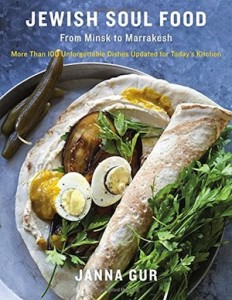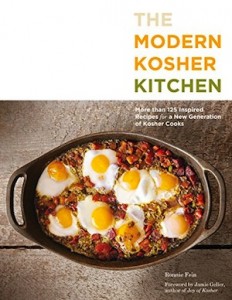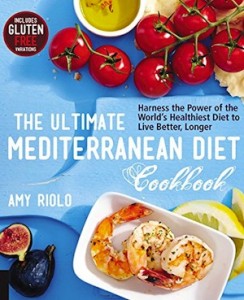While it might be hard to contemplate cooking on these hot summer days, there are a few recent cookbooks enticing enough to draw you into the kitchen – with savory results.
 Jewish Soul Food: From Minsk to Marrakesh (Schocken Publishers, 2014) is Janna Gur’s third cookbook. It follows The Book of New Israeli Food: A Culinary Journey (Schocken, 2008), and she also edited and published Fresh Flavors from Israel (Al Hashulchan, 2010).
Jewish Soul Food: From Minsk to Marrakesh (Schocken Publishers, 2014) is Janna Gur’s third cookbook. It follows The Book of New Israeli Food: A Culinary Journey (Schocken, 2008), and she also edited and published Fresh Flavors from Israel (Al Hashulchan, 2010).
Gur’s family immigrated to Israel from Riga, Latvia, in 1974. She completed a bachelor’s degree in English literature and art history and a master’s degree in translation and literary theory. In 1991, she and her husband founded Al Hashulchan, a Hebrew food magazine.
In an interview with thekitchn.com, Gur explains that she wrote this new cookbook “to give the North American audience a taste of what Jewish foods could be – how diverse and wonderful they are, and how possible it is to make them a part of our modern cooking.”
Gur’s aim was to make a focused, edited and approachable collection of 100 recipes from as many Jewish communities as possible. She wanted them to be authentic, to fit the modern kitchen and to answer the question, What is the soul of the dish “that makes us relish it and want to make it ours?”
The eight chapters include starters, salads and noshes (23 recipes); cozy soups for chilly nights (14 recipes); meat balls, fish balls and stuffed vegetables (10 recipes); braises, pot roasts and ragus (13 recipes); meatless mains (12 recipes); savory pastries (11 recipes); Shabbat state of mind (10 recipes); and cakes, cookies and desserts (20 recipes).
There are 94 color illustrations, which are beautiful and mouth-watering.
For me, as a cook, the three most useful aspects of a cookbook are all here: every recipe has its country of origin, a brief story and numbered instructions.
And what wonderful countries of origin for these recipes – Morocco, Hungary, Bulgaria, Romania, Algeria, Libya, North Africa, Georgia, Kurdistan, Russia, Persia, Syria, Turkey, Bulgaria, Iraq, India, Yemen and America. As the book’s promotional material notes, the cuisines from most of these countries may be “on the verge of extinction … because almost none of the Jewish communities in which they developed and thrived still exist. But they continue to be viable in Israel, where there are still cooks from the immigrant generations who know and love these dishes. Israel has become a living laboratory for this beloved and endangered Jewish food.” And the hope for Jewish Soul Food is that it will help “preserve traditional cuisine for future generations” by encouraging people to cook it.
For more about Gur, visit jannagur.com.
***
Former Wall Street lawyer Ronnie Fein decided to become a freelance food and kitchen appliance writer. This led to the Ronnie Fein School of Creative Cooking, lecturing and cooking demonstrations – and cookbooks. She has written several, but describes Hip Kosher: 175 Easy-to-Prepare Recipes for Today’s Kosher Cooks (Da Capo Press, 2008) and The Modern Kosher Kitchen: More than 125 Inspired Recipes for a New Generation of Kosher Cooks (Fair Winds Press, 2014) as “more labors of love.”
 She writes on her website (ronniefein.com): “They are, like this website, my efforts to bring the world of kosher cooking into 21st-century America. Just as our kosher ancestors cooked the same foods as their neighbors in Eastern Europe or the Middle East or wherever they happened to live, and adapted it to the dietary laws, why shouldn’t we, right here in America?”
She writes on her website (ronniefein.com): “They are, like this website, my efforts to bring the world of kosher cooking into 21st-century America. Just as our kosher ancestors cooked the same foods as their neighbors in Eastern Europe or the Middle East or wherever they happened to live, and adapted it to the dietary laws, why shouldn’t we, right here in America?”
Fein says she wrote The Modern Kosher Kitchen “to try to inspire all home cooks who keep kosher and would like to prepare the kinds of foods that informed, sophisticated – hip – folks want to cook today.”
And the focus is, indeed, on modern American recipes – “multicultural, innovative and interesting.” Every recipe is marked meat, dairy or pareve, and every recipe has some introductory remarks, which I think make the recipe so much more personal and interesting. As well, every recipe has a “Did you know?” or serving suggestions and substitutions. Most recipes also have a boxed tip, piece of advice. When a recipe runs to a second page, it is always opposite, so the cook does not have to turn the page while working.
The 12 chapters include appetizers; soups; salads; grains, beans, pasta and vegetarian dishes; fish; meat; poultry; vegetables and side dishes; breakfast, brunch and sandwiches; budget meals; Passover dishes and desserts. Ingredients are listed in imperial measurements as well as metric.
Although there are 127 recipes, there are only 39 beautiful, mouth-watering color photographs – but that is certainly not a reason to pass up this book. My only criticism about the cookbook is that the instructions are in paragraphs and not numbered, which I find easier to follow.
***
Rounding out these reviews is not a kosher cookbook per se, however, by eliminating the cheese or using pareve chicken stock, some of the recipes could be adapted.
 Amy Riolo (amyriolo.com) is an Italian American whose ancestors came from Calabria. She is the author of many cookbooks, a chef and a TV personality, so I felt that her most recent publication – The Ultimate Mediterranean Diet Cookbook (Fair Winds Press, 2015) – was worth noting.
Amy Riolo (amyriolo.com) is an Italian American whose ancestors came from Calabria. She is the author of many cookbooks, a chef and a TV personality, so I felt that her most recent publication – The Ultimate Mediterranean Diet Cookbook (Fair Winds Press, 2015) – was worth noting.
The 101 recipes in this book were included because of their taste, authenticity and nutritional value. They are low in fat, cholesterol and sodium, and packed with vitamins, minerals and healthful properties. There are also seven recipes specifically listed as alternatively gluten free.
The recipes are organized according to the Mediterranean diet pyramid with fruits, vegetables, grains, olive oil, beans, nuts, legumes and seeds, herbs and spices at the bottom, for every meal to be based on these foods. Above them are fish and seafood to be served twice a week. Above them are poultry, eggs, cheese and yogurt to be served in moderate portions daily or weekly. At the top of the pyramid are the least-served foods – meats and sweets.
Categorizing the recipes to give the reader an idea of what is included, one can find recipes for seven soups, five fish meals, four breads, six pasta, eight appetizers and sauces, five dips, three egg dishes, one sandwich, five poultry meals, eight side dishes, eight salads, eight main dishes, nine vegetables, 10 fruit dishes and six desserts.
Each recipe has a little story, the list of ingredients opposite the instructions (regrettably, not numbered) and a boxed Mediterranean lifestyle tip to “enhance the daily living aspects of the eating plan,” along with meal plans and serving suggestions.
At the end are a glossary with pantry foods defined, a bibliography and a selection of websites, magazine/newspaper articles and journals for further reading.
The 69 color illustrations are so tempting cooks will be motivated to rush to the kitchen to start making these dishes.
Sybil Kaplan is a journalist, foreign correspondent, lecturer, food writer and book reviewer who lives in Jerusalem. She also does the restaurant features for janglo.net and leads weekly walks in English in Jerusalem’s market.
